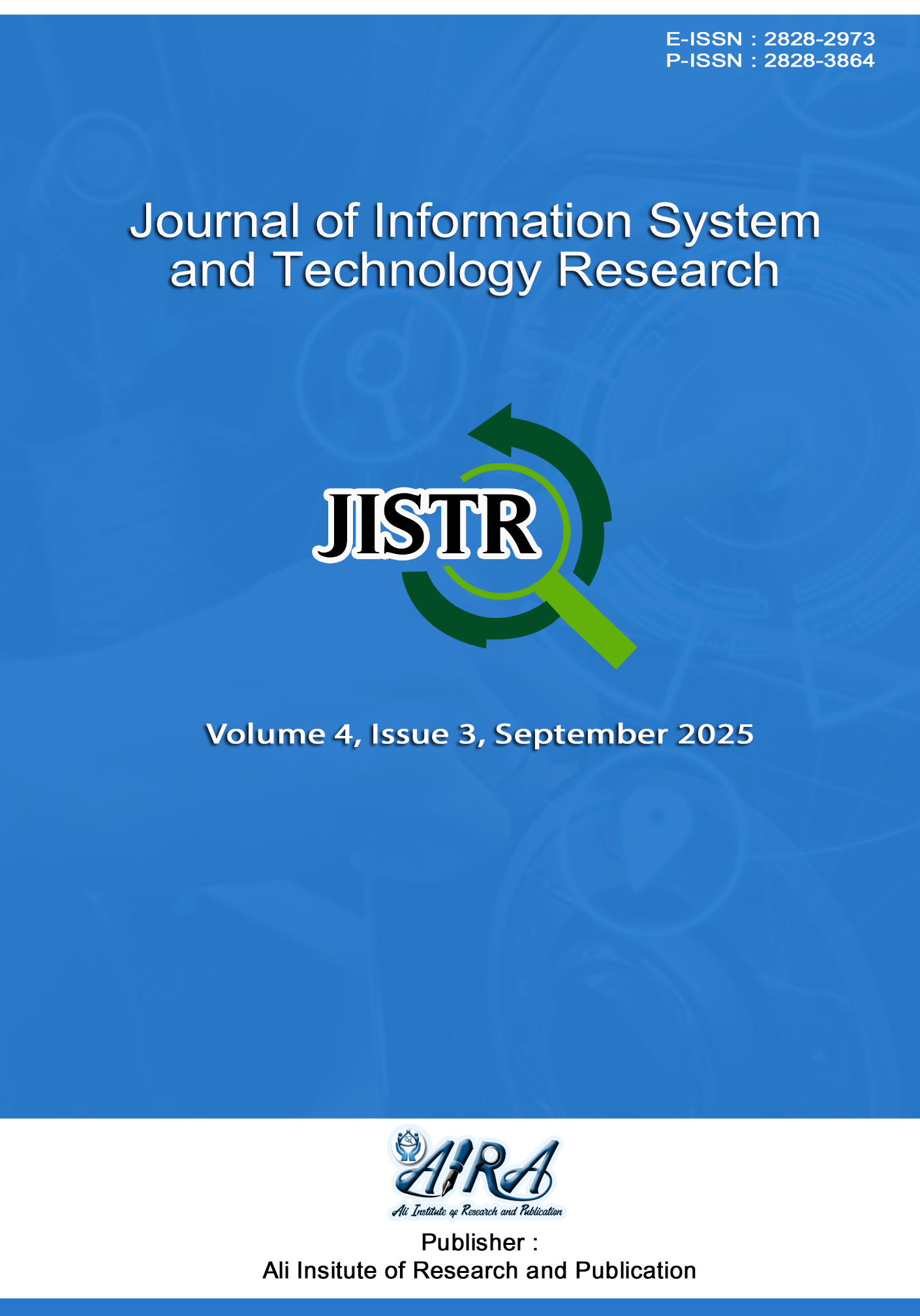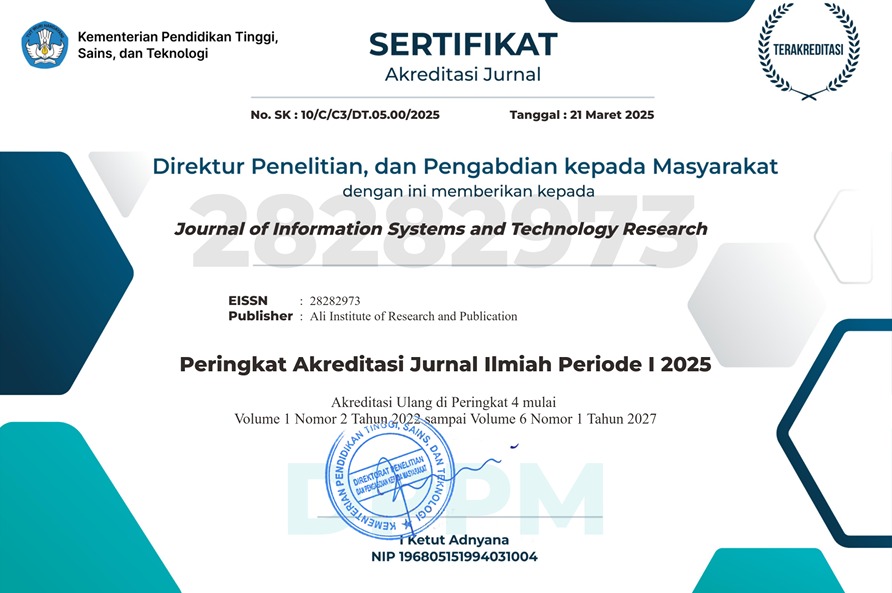Design and Development of Web-Based E-Learning System Using Waterfall for Evaluation
DOI:
https://doi.org/10.55537/jistr.v4i3.1269Keywords:
E-Learning, Web-based system, Information System, Waterfall, Educational TechnologyAbstract
The learning evaluation process at SMK Assyafi’iyah 02 still encounters fundamental challenges, including the absence of an integrated digital system, reliance on manual distribution of questions and answers, frequent delays in score recapitulation, and limited transparency between teachers and students. These conditions often result in inefficiency, data inaccuracy, and difficulties in monitoring students’ academic progress in real time. The research problem addressed in this study is how to design and implement a web-based e-learning application that is able to overcome these obstacles and support more effective evaluation. Therefore, the purpose of this study is to build an information system that integrates exam management, online submission, automated scoring, manual correction, a nd role-based access, with the goal of improving the speed, accuracy, and transparency of learning evaluations. This study applies the Waterfall development method consisting of requirement analysis, system design, implementation, and testing to ensure a structured and systematic process. The contribution of this research lies in providing a practical digital platform for schools that have not yet fully adopted e-learning systems, while the novelty is reflected in the integration of evaluation, communication, and monitoring features specifically adapted to the learning context of vocational schools. The testing results show that the system developed is able to reduce evaluation time, improve data accuracy, and provide better accessibility for both teachers and students.
Downloads
References
[1] Abdul Aziz, A. R., Anuar Rahimi, M. K., Shafie, A. A. H., Soffian Lee, U. H., & Mohd Yusof, S. N. (2021, December 1). Online Learning: A Coping Strategy towards Academic Stress amid New Norms. Sains Insani, 6(2), 96–104. https://doi.org/10.33102/sainsinsani.vol6no2.288
[2] Abu Hassan, S. A., Zainol Abidin, S. B., & Hassan, Z. B. (2021, March 8). Effectiveness of Online Teaching and Learning (E-Learning) on Student Learning at Hulu Langat Community College. International Journal of Humanities Technology and Civilization (IJHTC), 6(2), 1–8. https://doi.org/10.15282/ijhtc.v6i(S2).6241
[3] Adhi Pratama, R. A., Mahmud, Aprizal, Y., Syaftriandi, & Setiawan, E. (2023, February 5). Usability Testing of the PalComTech Online Learning Android Application Using the PACMAD Method. Jurnal Multidisiplin Ilmu, 2(1). https://www.journal.mediapublikasi.id/index.php/bullet/article/view/2161
[4] Alfath Yauma, Iskandar Fitri, & Sari Ningsih. (2020, December 8). Web-Based Learning Management System (LMS) Development for E-Learning Using Agile and Waterfall Methods. Jurnal Teknologi Informasi dan Komunikasi, 5(3), 323–328. https://doi.org/10.35870/jtik.v5i3.190
[5] Aqsal Fawwazi Satrio Wibowo & Margaretha Evi Yuliana. (2024, October 23). Utilization of E-Learning as a Learning Medium for University Students. Jurnal Ilmiah Bisnis dan Sosial, 2(3), 374–378. https://jurnal.ittc.web.id/index.php/jibs/article/view/1714
[6] Ardhani, R., Munir, M. M., & Dawis, A. M. (2023, August 28). Application of the Waterfall Method in Designing a Web-Based E-Learning Information System at MTs Al-Wusho. Jurnal Innovation and Future Technology (IFTECH), 5(2), 64–73. https://doi.org/10.47080/iftech.v5i2.2754
[7] Ayu Lestari Dalimunthe. (2022, January). Web-Based E-Learning Information System at SMA Negeri 1 Rantau Selatan. Journal of Student Development Informatics Management (JoSDIM), 1(1), 1–11. https://jurnal.ulb.ac.id/index.php/JoSDIM/article/view/2913
[8] Fransisca, M., & Yunus, Y. (2021, December 12). Practicality Level of Using E-Learning in the Blended Learning Model at the High School Level. KomtekInfo, 8(4), 212–219. https://doi.org/10.35134/komtekinfo.v8i4.184
[9] Gusti Selfi & Akmal, A. (2021, October 31). Implementation of E-Learning-Based Learning during COVID-19 for 2020 Cohort PPKn Students at UNP. Journal of Civic Education, 4(3), 212–218. https://doi.org/10.24036/jce.v4i3.543
[10] Khairani, D., Iqbal, M., Rosyada, D., Zulkifli, Z., & Mintarsih, F. (2021, December 16). Acceptance of Arabic Language Learning Systems with E-Learning and Games during the COVID-19 Pandemic. Jurnal Penelitian Pendidikan Agama dan Keagamaan, 19(3), 346–361. https://doi.org/10.32729/edukasi.v19i3.958
[11] Mohamad, A. M. (2022, March 1). Analysis of E-Learning Portal Usage Patterns and Subject Achievement. Journal of ICT in Education (JICTIE), 9(1), 100–116. https://doi.org/10.37134/jictie.vol9.1.9.2022
[11] Priamnistiko, A., Handrianto, Y., & Sukmana, S. H. (2021, March). Design and Development of an E-Learning Information System Using the Waterfall Model. Jurnal Inovasi Informatika Universitas Pradita, 6(1), 50–57. https://doi.org/10.51170/jii.v6i1.143
[12] Putra Prima Arhandi, Sofyan Noor Arief, & Annisa Taufika Firdausi. (2022, November 28). Development of a Website to Support Mastery-Based Learning for University Students. JIP (Jurnal Informatika Polinema), 9, 51–58. https://doi.org/10.33795/jip.v9i1.966
[13] Ratnasari, A. (2012, June 15). Study of the Effect of E-Learning Implementation on Student Activeness in Teaching and Learning Activities: A Case Study at Mercu Buana University Jakarta. In Proceedings of the SNATI Conference. https://journal.uii.ac.id/snati/article/view/2930
[14] Riska Handayani, Zul Rachmat, & Wahyuddin S. (2022, October 31). Design of a Web-Based E-Learning Application at SMP Negeri 3 Watansoppeng. Jurnal Manajemen dan Sistem Informasi Teknik (JUMISTIK), 1(1), 43–54. https://doi.org/10.70247/jumistik.v1i1.8
[15] Risma Nadia Oktavianti, Sufajar Butsianto, & Abdul Halim Anshor. (2024, January 31). Web-Based E-Learning Information System at SMA Negeri 3 Cikarang Utara. Riset dan E-Jurnal Manajemen Informatika Komputer, 8(1), 410–424. https://doi.org/10.33395/remik.v8i1.13423
[16] Setiyanto, S., & Yasin, I. F. (2023, December 30). User Interface Analysis of an E-Learning Website Using the Heuristic Evaluation Method. Indonesian Journal of Multidisciplinary on Social and Technology, 1(3), 327–332. https://doi.org/10.31004/ijmst.v1i3.293
[17] Styawati, F. A., Alita, D., & Susanto, E. R. (2020). From Traditional to Millennial Learning: Development of a Web-Based Application to Support E-Learning at MAN 1 Pesawaran. Journal of Social Science and Technology for Community Service, 1(2), 10–16. https://www.academia.edu/download/90223619/496.pdf
[18] Styawati, S., Oktaviani, L., & Lathifah, L. (2021, July 31). Implementation of a Web-Based Online Learning System at MAN 1 Pesawaran. Jurnal Widya Laksmi, 1(2), 68–75. https://doi.org/10.59458/jwl.v1i2.15
[19] Sukmawati, S. A., Uloli, R., & Abdjul, T. (2023, August 25). Website Development as a Physics Learning Media on Heat and Heat Transfer Materials. Jurnal Penelitian Pendidikan IPA (JPPIPA), 9(8), 5874–5883. https://doi.org/10.29303/jppipa.v9i8.4189
[20] Mohamad, A. M. (2022, March 1). Analysis of E-Learning Portal Usage Patterns and Subject Achievement. Journal of ICT in Education (JICTIE), 9(1), 100–116.
[21] Hidayatullah, A., & Pramana, E. B. (2021). Pengembangan Media E-Learning Berbasis Website untuk Pembelajaran. Jurnal Edukasi dan Teknologi Pembelajaran, 3(2), 151–160. https://doi.org/10.31004/edukasi.v3i2.151
[22] Sina, S. A., Uloli, R., & Abdjul, T. (2023). Website Development as a Physics Learning Media on Heat and its Transfer Materials. Jurnal Penelitian Pendidikan IPA, 9(8), 5874–5883. https://doi.org/10.29303/jppipa.v9i8.4189
[23] Abu Hassan, S. A., Zainol Abidin, S., & Hassan, Z. (2021). Keberkesanan Pembelajaran dan Pengajaran dalam Talian (E-Pembelajaran) terhadap Pembelajaran Pelajar di Kolej Komuniti Hulu Langat. International Journal of Humanities Technology and Civilization, 6(S2), 1–8. https://doi.org/10.15282/ijhtc.v6i(S2).6241
[24] Rogahang, S. S. N. (2025). Application of Artificial Intelligence (AI) Technology in Online Learning System. Indonesian Journal of Society Development, 4(3), 123–138. https://doi.org/10.55927/ijsd.v4i3.375
[25] Maharani, A., Baharudin, Y., Yanti, Y., & Shabira, Q. (2025). Analisis Literatur Blended Learning di Era Abad ke-21 pada Sekolah Dasar: Tinjauan Bibliometrik. Action Research Journal Indonesia, 7(1), 555–579. https://doi.org/10.61227
Downloads
Published
How to Cite
Issue
Section
License
Copyright (c) 2025 Rahardian Septianto, Ari Hidayatullah

This work is licensed under a Creative Commons Attribution-ShareAlike 4.0 International License.







